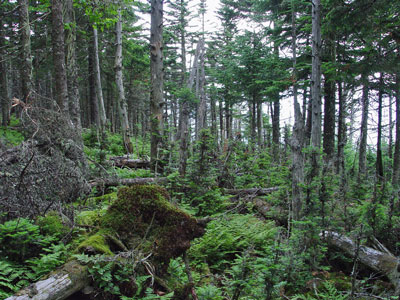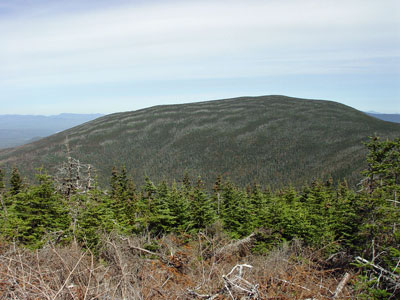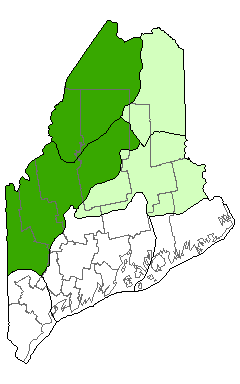DACF Home → Bureaus & Programs → Maine Natural Areas Program → Communities, Plants, and Animals → Natural Community Fact Sheets → Subalpine Fir Forest
Printer Friendly Fact Sheet - 1 MB pdf (Get a free copy of Adobe Acrobat Reader)
Subalpine Fir Forest
Scientific Name: Fir - Heart-leaved Birch Subalpine Forest; State Rank: S3

- Community Description
- Soil and Site Characteristics
- Diagnostics
- Similar Types
- Conservation, Wildlife and Management Considerations
- Distribution
- Characteristic Plants
- Associated Rare Plants
- Associated Rare Animals
- Examples on Conservation Lands You Can Visit
Community Description: Balsam fir, or mixtures of fir and heart-leaved birch, form a dense canopy of somewhat stunted trees. Patches of heart-leaved birch and mountain ash are common where wind, fire, or landslides have created openings, along with a dense shrub layer of mountain ash, hobblebush, and regenerating fir. Herbs may be sparse, or may form locally dense patches in openings; wood ferns and big-leaved aster in particular tend to be patchy. In some expressions of this type that have developed after fire, the canopy consists almost entirely of paper birch or heart-leaved birch. Fir waves, an unusual landscape pattern of linear bands of fir dieback and regeneration, are another variant of this community. Back to top.

Soil and Site Characteristics: These forests are commonly found above 2700’ on level ridgetops and steep, upper slopes. The mineral soil layer is thin, typically 10-30 cm, and rocky. Natural disturbances such as landslides, wind, fire, and spruce-budworm can exert lasting influences on community dynamics. Recurrent landslides can keep some areas in birch - mountain-ash dominance. Back to top.
Diagnostics: Fir or heart-leaved birch (occasionally paper birch) are dominant in a subalpine setting. Back to top.
Similar Types: One form of the Maritime Spruce - Fir Forest type is compositionally very similar but occurs at sea level in the extreme environment of the Downeast coast. Decreasing in elevation, this type can grade into Montane Spruce - Fir Forest or Lower-elevation Spruce - Fir Forest, which are distinguished by their higher proportion of spruce in the canopy and by less stunted trees. Back to top.
Conservation, Wildlife and Management Considerations: Although subalpine forests are naturally dynamic as they cycle through periods of weather and insect damage and regeneration, they appear to be relatively stable in overall extent, and are extensive on Maine's higher mountains. Many major occurrences are well protected within public lands or private conservation lands. On the few remaining sites on private lands, timber harvesting, recreation, and windpower development could cause lasting impacts. At some sites, past harvesting has resulted in prolific growth of hay-scented and mountain wood fern, inhibiting tree regeneration.
This high-elevation forest community type may be used as nesting habitat by a number of high elevation and/or coniferous forest specialist bird species, such as the spruce grouse, dark-eyed junco, bay-breasted warbler, black-backed woodpecker, white-throated sparrow, and blackpoll warbler. The rare Bicknell's thrush inhabits structurally complex forests above 2500'. The rock vole and long-tailed shrew both inhabit cool moist crevices in rocky habitat at high elevations. Northern bog lemmings may inhabit wet sub-alpine spruce - fir forests in which peat moss is present. Back to top.
Distribution: Western and central Maine westward (New England - Adirondack Province); likely extends northeasterly to the Gaspé peninsula. Landscape Pattern: Large Patch. Back to top.


Characteristic Plants: These plants are frequently found in this community type. Those with an asterisk are often diagnostic of this community.
- Canopy
- Balsam fir*
- Heart-leaved paper birch
- Paper birch*
- Red spruce
- Sapling/shrub
- Balsam fir*
- Black spruce*
- Heart-leaved paper birch*
- Mountain ash*
- Wild-raisin
- Herb
- Balsam fir*
- Big-leaved aster*
- Bluebead lily
- Mountain woodfern*
- Northern wood-sorrel
- Spinulose wood fern*
- Starflower
- Bryoid
- Common broom-moss
- Three-lobed bazzania
There are no documented rare animals associated with this natural community.
Examples on Conservation Lands You Can Visit
| Example | County |
|---|---|
| Baxter State Park | Piscataquis Co. |
| Big Squaw Mountain Public Lands | Piscataquis Co. |
| Bigelow Preserve Public Lands | Somerset Co. |
| Crocker Mountain, Appalachian Trail | Franklin Co. |
| Mahoosuc Mountain, Mahoosuc Public Lands | Oxford Co. |
| Sugarloaf Mountain, Appalachian Trail | Franklin Co. |